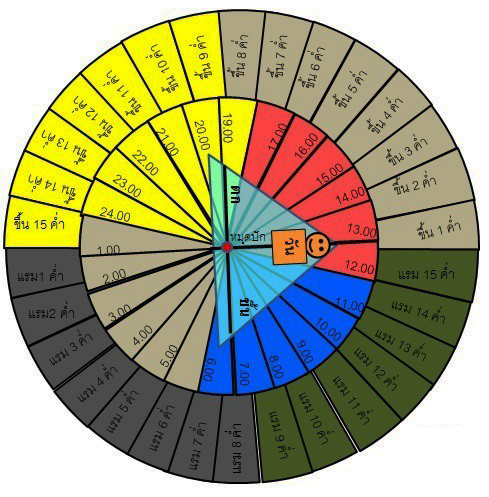แบบจำลองทางเลือกสำหรับการจัดกิจกรรมการเรียนรู้เพื่อแสดงเวลาขึ้นและตกโดยประมาณของดวงจันทร์และหน่วยเวลา โมงเช้า โมงเย็น ทุ่ม ตี
Main Article Content
Abstract
Pattawan Narjaikaew
รับบทความ: 12 พฤศจิกายน 2557; ยอมรับตีพิมพ์: 30 มีนาคม 2558
บทคัดย่อ
ถึงแม้ว่าปัจจุบันคนส่วนใหญ่ทั่วโลกจะคุ้นเคยกับหน่วยเวลาที่เป็นสากลคือ นาฬิกา ซึ่งใน 1 วันจะแบ่งออกเป็น 24 ชั่วโมงโดยมีความสัมพันธ์กับเวลาขึ้นและตกของดวงอาทิตย์ อย่างไรก็ตามในประเทศไทยยังมีการกำหนดหน่วยเวลาอีกหน่วย ซึ่งประกอบด้วยหน่วยเวลาย่อย 4 หน่วยคือ โมงเช้า โมงเย็นหรือบ่ายโมง ทุ่ม และตี ซึ่งยังเป็นที่นิยมใช้อยู่ในปัจจุบันโดยหน่วยเวลาดังกล่าวมีความสัมพันธ์กับเวลาขึ้น-ตกของดวงจันทร์ ในกิจกรรมการเรียนการสอนในห้องเรียนที่เกี่ยวข้องกับดวงจันทร์นั้นยังมีการเชื่อมโยงถึงประเด็นหน่วยเวลาไทยกับเวลาขึ้น-ตกของดวงจันทร์ไม่มาก ดังนั้นรายงานนี้จึงต้องการนำเสนอแบบจำลองทางเลือกสำหรับการจัดกิจกรรมการเรียนรู้สำหรับผู้สอนในกลุ่มสาระการเรียนรู้วิทยาศาสตร์ เกี่ยวกับเวลาขึ้นและตกของดวงจันทร์ที่แสดงความสัมพันธ์ระหว่างหน่วยเวลาไทย โดยเป็นแบบจำลองอย่างง่ายที่ใช้วัสดุอุปกรณ์ที่หาได้ง่ายและราคาถูก (คือกระดาษแข็ง) ซึ่งแบบจำลองนี้จะช่วยให้ผู้เรียนรู้เวลาขึ้นและตกโดยประมาณของดวงจันทร์วันข้างขึ้น-ข้างแรมต่าง ๆ ซึ่งช่วยให้ง่ายต่อการจำ เมื่อรู้เวลาขึ้นและตกของดวงจันทร์ในแต่ละวันแล้ว จะสามารถวางแผนสำหรับการจัดกิจกรรมการดูดาวในเวลากลางคืนได้ในวันที่เหมาะสม เนื่องจากต้องเป็นวันและเวลาไม่มีแสงรบกวนจากดวงจันทร์
คำสำคัญ: แบบจำลองทางเลือก เวลาขึ้นและตกของดวงจันทร์ หน่วยเวลา โมงเช้า โมงเย็น ทุ่ม ตี
Abstract
Most of the countries use the time of day with their local solar time based on the Sun's position in the sky. The unit of time measurement is hour, and there are 24hours a day. Alternatively, the hour of the day in Thailand are called as Mong-Chao, Mong-Yen or Bai-Mong, Toom, and Tee which are related to the time of moonrise and moonset through a month. However, there is rarely made this link to classroom. Therefore, this article aims to present an alternative model which shows the relationship between time of moonrise/moonset and Thai time unit of Mong-Chao, Mong-Yen, Toom and Tee. It is easy to use to assist students to know and remember the time of moonrise/moonset through a month since it is related to Thai time unit. In addition, teachers are able to plan the date and time for doing star observation activity because during viewing the night sky could not be affected by the moonlight.
Keywords: Alternative model, Time of moonrise and moonset, Mong-Chao, Mong-Yen or Bai- Mong, Toom and Tee
Downloads
Article Details

This work is licensed under a Creative Commons Attribution-NonCommercial 4.0 International License.
References
กระทรวงศึกษาธิการ. (2551). หลักสูตรการศึกษาขั้นพื้นฐานพุทธศักราช 2551. กรุงเทพฯ: ชุมนุมสหกรณ์การเกษตรแห่งประเทศไทย.
พันธ์ ทองชุมนุม. (2547). การสอนวิทยาศาสตร์. กรุงเทพฯ: โอเดียนสโตร์.
Bennett, J., Lubben, F., and Thompson, G. H. (2013). Schools that make a difference to post-compulsory uptake of physical science subjects: Some comparative case studies in England. International Journal of Science Education 35(4): 663–689.
Bueter, C. (2012). Moon Finder activity with paper plates. Retrieved November 1, 2014, from http://analyzer.depaul.edu/paperplate/Moon%20Finder.htm
Chang, W., Jones, A., and Kunnemeyer, R. (2002). Interactive teaching approach in year one university physics in Taiwan: Implementation and evaluation. Asia-Pacific Forum on Science Learning and Teaching 3(1): 217–217.
Duit, R., and Treagus, D. F. (2003). Conceptual change: A powerful framework for improving science teaching and learning. Inter-national Journal of Science Education 25(6): 671–688.
Engelhardt, P. V., and Beichner, R. J. (2004). Teachers’ understanding of direct current resistive electrical circuits. American Journal of Physics 72(1): 98–115.
Krell, M., Belzen, A. U., and Krüger, D. (2012). Students’ understanding of the purpose of models in different biological contexts. International Journal of Biology Education 2(2): 1–34.
Osborne, J. F., Simon, S., and Collins, S. (2003). Attitudes towards science: A re-view of the literature and its implications. International Journal of Science Education 25(9): 1049–1079.
Schwarz, V., Reiser, B. J., Davis, E. A., Kenyon, L., Achér, A., Fortus, D., and others. (2009). Developing a learning progress-ion for scientific modeling: Making scientific modeling accessible and meaningful for learners. Journal of Research in Science Teaching 46(6): 632–654.
Shwartz, Y., Rogat, A., Merritt, J., and Krajcik, J. (2007, April). The effect of classroom practice on students understanding of models. A paper presented at the annual meeting of the National Association of Research in Science Teaching. New Orleans, LA.
Tasakorn, P., and Pongtabodee, S. (2005). Research report: Science and technology curriculum for primary, secondary, and ternary education in Thailand. Bangkok: The Secretarial of the Senate.
Treagust, D. V., Chittleborough, G., and Mamiala, T. L. (2002). Students’ understanding of the role of scientific model in learning science. International Journal of Science Education, 24(4). 357–368.
